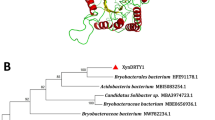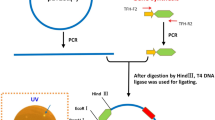Abstract
A novel xylanase-producing thermophilic strain MT-1 was isolated from a deep-sea hydrothermal field in east Pacific. A xylanase gene encoding 331 amino-acid peptide from this isolate was cloned and expressed in Escherichiacoli. The recombinant xylanase exhibited maximum activity at 70°C and had an optimum pH of 7.0. It was active up to 90°C and showed activity over a wide pH ranging from 5.5 to 10.0. The crude xylanase presented similar properties in temperature and pH to those of the recombinant xylanase. The recombinant xylanase was stable in 1 mM of enzyme inhibitors (PMSF, EDTA, 2-ME or DTT) and in 0.1% detergents (Tween 20, Chaps or Triton X-100), whereas, it was strongly inhibited by sodium dodecyl sulfate (SDS) (1 mM). In addition, its catalytic function was stable in the presence of Li+, Na+ or K+. However, it was strongly inhibited by Ni2+, Mn2+, Co2+, Cu2+, Zn2+, Cd2+, Hg2+ and Al3+ (1 or 0.1 mM). The K m and V max of the recombinant xylanase for oat spelt xylan were calculated to be 1.579 mg/ml and 289 μmol/(min • mg), respectively. Our study, therefore, presented a rapid overexpression and purification of xylanase from deep-sea thermophile aimed at improving the enzyme yield for industrial applications and scientific research.




Similar content being viewed by others
References
Bailey MJ, Biely P, Poutanen K (1992) Interlaboratory testing of methods for assay of xylanase activity. J Biotechnol 23:257–270
Beg QK, Kapoor M, Mahajan L, Hoondal GS (2001) Microbial xylanases and their industrial applications. Appl Microbiol Biotechnol 56:326–338
Bergquist PL, Gibbs MD, Morris DD, TeÓ VSJ, Saul DJ, Morgan HW (1999) Molecular diversity of thermophilic cellulolytic and hemicellulolytic bacteria. FEMS Microbiol Ecol 28:99–110
Biely P (1985) Microbial xylanolytic systems. Trends Biotechnol 3:286–290
Blanco A, Díaz P, Zueco J, Parascandola P, Pastor FIJ (1999) A multidomain xylanase from a Bacillus sp. with a region homologous to thermostabilizing domains of thermophilic enzymes. Microbiology 145:2163–2170
Bradford MM (1976) A rapid sensitive method for the quantitation of microgram quantities of protein utilizing the principle of protein–dye binding. Anal Biochem 72:248–254
Christakopoulos P, Katapodis P, Kalogeris E, Kekos D, Macris BJ, Stamatis H, Skaltsa H (2003) Antimicrobial activity of acidic xylooligosaccharides produced by family 10 and 11 endoxylanases. Int J Biol Macromol 31:171–175
Clarke JH, Davidson K, Gilbert HJ, Fontes C, Hazlewood GP (1996) A modular xylanase from mesophilic Cellulomonasfimi contains the same cellulose-binding and thermostabilizing domains as xylanases from thermophilic bacteria. FEMS Microbiol Lett 139:27–35
Connerton I, Cumming N, Harris GW, Debeire P, Breton C (1999) A single domain thermophilic xylanase can bind insoluble xylan: evidence for surface aromatic clusters. Biochim Biophys Acta 1433:110–121
Fontes CM, Hazlewood GP, Morag E, Hall J, Hirst BH, Gilbert HJ (1995). Evidence for a general role for non-catalytic thermostabilizing domains in xylanases from thermophilic bacteria. Biochem J 307:151–158
Gibbs MD, Reeves RA, Bergquist PL (1995) Cloning sequencing and expression of a xylanase Gene from the extreme thermophile Dictyoglomusthermophilum Rt46B.1 and activity of the enzyme on fiber-bound substrate. Appl Environ Microbiol 61:4403–4408
Gilkes NR, Henrissat B, Kilburn DG, Miller RC, Warren RAJ (1991) Domains in microbial β-1,4-glycanases; sequence conservation, function, and enzyme families. Microbiol Rev 55:303–315
Khanna S, Gauri P (1993) Regulation, purification and properties of xylanase from Cellulomonasfimi. Enzyme Microb Technol 15:990–995
Kulkarni N, Shendye A, Rao M (1999) Molecular and biotechnological aspects of xylanases. FEMS Microbiol Rev 23:411–456
Lineweaver H, Burk D (1934) The determination of enzyme dissociation constants. J Am Chem Soc 57:685
Martínez MA, Delgado OD, Baigorí MD, Siòeriz F (2005) Sequence analysis, cloning and over-expression of an endoxylanase from the alkaliphilic Bacillushalodurans. Biotechnol Lett 27:545–550
Miller GL (1959) Use of dinitrosalicylic reagent for determination of reducing sugars. Anal Chem 31:426–428
Oppenheimer CH, ZoBell CE (1952) The growth and viability of sixty-three species of marine bacteria as influenced by hydrostatic pressure. J Mar Res 11:10–18
Shah AR, Madamwar D (2005) Xylanase production by a newly isolated Aspergillusfoetidus strain and its characterization. Process Biochem 40:1763–1771
Shibuya H, Kaneko S, Hayashi K (2000) Enhancement of the thermostability and hydrolytic activity of xylanase by random gene shuffling. Biochem J 349:651–656
Subramaniyan S, Prema P (2002) Biotechnology of microbial xylanases: enzymology, molecular biology, and application. Crit Rev Biotechnol 22:33–64
Sunna A, Antranikian G (1997) Xylanolytic enzymes from fungi and bacteria. Crit Rev Biotechnol 17:39–67
Sunna A, Gibbs MD, Bergquist PL (2000) A novel thermostable multidomain 1,4-β-xylanase from ‘Caldibacilluscellulovorans’ and effect of its xylan-binding domain on enzyme activity. Microbiology 146:2947–2955
Viikari L, Kantelineo A, Bundquist J, Linko M (1994) Xylanase in bleaching: from an idea to the industry. FEMS Microbiol Rev 13:335–350
Viikari L, Sundquist J, Kettunen J (1991) Xylanase enzymes promote pulp bleaching. Pap Puu (Pap Tim) 73:384–389
Wong KY, Tan LUL, Saddler JN (1988) Multiplicity of β-1,4-xylanase in microorganisms: functions and applications. Microbiol Rev 52:305–317
Xiaoyan W, Jianyi S (2005) Construction, expression and characterization of a thermostable xylanase. Curr Microbiol 51:188–192
Acknowledgements
This work was financially supported by the China Ocean Mineral Resources R & D Association (DY105-02-04-05) and the National Natural Science Foundation of China (40576076).
Author information
Authors and Affiliations
Corresponding author
Rights and permissions
About this article
Cite this article
Wu, S., Liu, B. & Zhang, X. Characterization of a recombinant thermostable xylanase from deep-sea thermophilic Geobacillus sp. MT-1 in East Pacific. Appl Microbiol Biotechnol 72, 1210–1216 (2006). https://doi.org/10.1007/s00253-006-0416-4
Received:
Revised:
Accepted:
Published:
Issue Date:
DOI: https://doi.org/10.1007/s00253-006-0416-4




